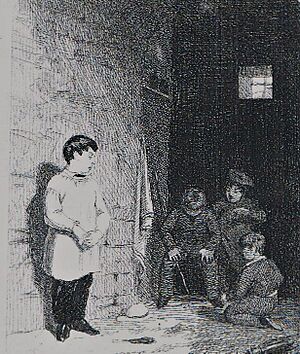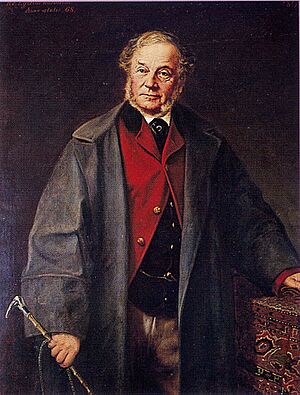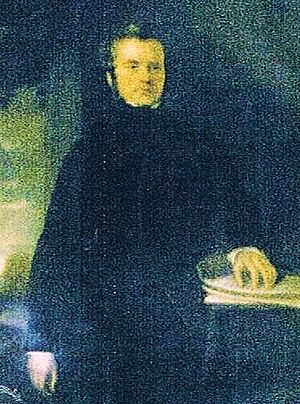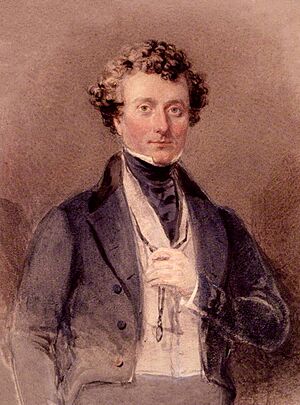Charles Allen Duval facts for kids
Quick facts for kids
Charles Allen Duval
|
|
|---|---|
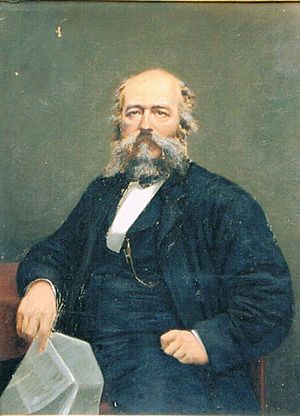
Self Portrait
|
|
| Born | 19 March 1810 |
| Died | 14 June 1872 (aged 62) Bollin Fee, Cheshire, England
|
| Nationality | British |
| Occupation | Portrait painter Photographer Literary critic Illustrator Writer |
| Known for | Manchester Academy of Fine Arts Manchester City Art Gallery Art Treasures Exhibition, Manchester 1857 |
Charles Allen Duval (born March 19, 1810 – died June 14, 1872) was a famous Victorian artist. He was known for painting portraits, taking photos, writing about books, and illustrating stories. He played a big part in the art scene in Manchester, England. Many important people, like business owners and politicians, wanted him to paint their pictures.
Contents
Life of a Victorian Artist
Duval was born in Beaumaris, Anglesey, Wales. This was on March 19, 1810. He started his art journey in Liverpool. He married Elizabeth Renney and they had nine children. Two of his sons, Edward and Gerald, also became artists. Gerald's daughter, Bessie Du Val, painted and illustrated books too.
His oldest son, Charles, became a photographer. He joined his father's business, C. A. Duval & Co. This company started in the 1860s and lasted for 40 years.
Duval had art studios in Liverpool, Manchester, and London. He even opened a studio on the Isle of Man for his summer work.
In 1833, Duval moved to Manchester. He worked for art dealers named Messrs. Agnew & Zanetti.
Building Manchester's Art Scene
In Manchester, Duval helped start the Art Academy. This group held art shows every year. His big idea was to create a permanent public art gallery. This idea later became the Royal Manchester Institution.
He was one of the first members of the Manchester Academy of Fine Arts in 1859. He also joined the Brasenose Club. Other famous members included Charles Halle and Edwin Waugh.
A friend, Alfred Darbyshire, described Duval as a "distinguished looking man" who wore a Scotch plaid and a black sombrero. Duval was also part of other important groups. These included the Portico Library and the Manchester Chess Club, where he was once president.
Duval showed two of his paintings at the famous Art Treasures Exhibition, Manchester 1857. These were 'Forgotten Vows' and 'Recalled to Memory'. He also showed a portrait at the Royal Jubilee Exhibition, Manchester 1887.
He exhibited his art for 36 years at the Royal Academy in London.
His Final Days
Charles Allen Duval passed away on June 14, 1872. He was painting a family portrait in Alderley Edge when he suddenly became ill.
The Dictionary of National Biography said that his portraits were very good likenesses. They also noted his "considerable artistic merit," especially his chalk drawings of children. His work was known for its "great taste and beauty."
Famous Artworks
One of Duval's first well-known paintings was The Ruined Gamester. A print seller in Manchester bought it and made copies. It became so popular that a cartoon in Punch was even based on it!
Duval also created etchings (a type of printmaking) for 'The North of England Magazine' in 1842. Some of these included:
- Dr Dalton
- The Resident Pupil's Supper
- Hulme Hall
- The Ruined Gamester
He painted portraits of many important people. These included Charles Halle, Joseph Whitworth, and the inventor Joseph Burch. Burch's portrait is now in the Science Museum.
Duval painted an oil portrait of Joseph Burch. Some of Burch's inventions are also at the Science Museum, like a machine for printing on fabric.
For a full list of Duval's works, you can check the 'Arnold Hyde Dictionary' at Manchester Art Gallery.
Portraits of Important People
Many rich and famous people wanted Duval to paint their portraits. You can see some of these on the website of the National Portrait Gallery, London. He painted members of important families, like Rowland Eyles Egerton-Warburton. Rowland built the beautiful Arley Hall in Cheshire. Duval painted both Rowland and his mother. Their portraits still hang in the Drawing Room at Arley Hall today.
Pastel Artworks
Duval's pastel portraits were also very popular. He used pastels to draw both adults and children. One famous pastel portrait is of the three oldest daughters of the writer Elizabeth Cleghorn Gaskell. Elizabeth's husband, William Gaskell, was a minister and the first chairman of the Portico Library. He likely knew Duval well.
Painting Politicians
Duval painted many important politicians. These included John Bright, Daniel O'Connell, Richard Cobden, and Charles Pelham Villiers. Daniel Lee, one of Duval's first supporters, asked him to paint a life-size picture of O'Connell.
Most of these portraits were done in oil paint. Sometimes, he used watercolour, like for the portrait of Thomas Milner Gibson in the National Portrait Gallery, London.
He also created a series of watercolour portraits of leaders from the Anti-Corn Law League. These were printed and even put on pocket handkerchiefs!
History Paintings
Duval also painted "history paintings." These are large artworks that show important events or stories. One example is The Methodist Centenary. This painting showed 100 portraits of important Wesleyan leaders. They had gathered in Manchester to celebrate 100 years of Methodism.
Another big painting was Luther Burning the Pope's Bull. This artwork was very large, about 3 meters by 1.8 meters. It showed many figures and was displayed in Westminster Hall and other towns.
He also painted "Columbus in chains" in 1855, which was shown at the Royal Academy.
Photography Work
In the 1860s, Duval opened his own photography studio in Manchester. He believed that combining his art skills with photography would create better pictures.
He offered many types of photography services:
- Miniature Portraits
- Oil and Water-Colour Portraits
- Copies of Pictures (made smaller or larger)
- Group Photos
- Quick Portraits of Children
- Crayon and Pastel Portraits
- Life-Size Oil Portraits
Duval also made popular Carte-de-visite portraits. These were small photographs, made famous by Queen Victoria. When Prince Albert died in 1861, over 70,000 of his carte-de-visite portraits were sold in just one week!
Duval's carte-de-visite portraits included famous people like Joseph Whitworth, William Fairbairn, and Charles Halle. You can see some of these on the National Portrait Gallery website. Duval's techniques made it possible for more people to afford their own portraits.
Many of his photos, paintings, and drawings were officially registered. Copies of these works are kept at The National Archives (United Kingdom).
Writing and Illustrations
In 1863, Duval wrote five short books about the American Civil War.
He also wrote funny articles for magazines. He would draw his own sketches to go along with his writing.
Images for kids


